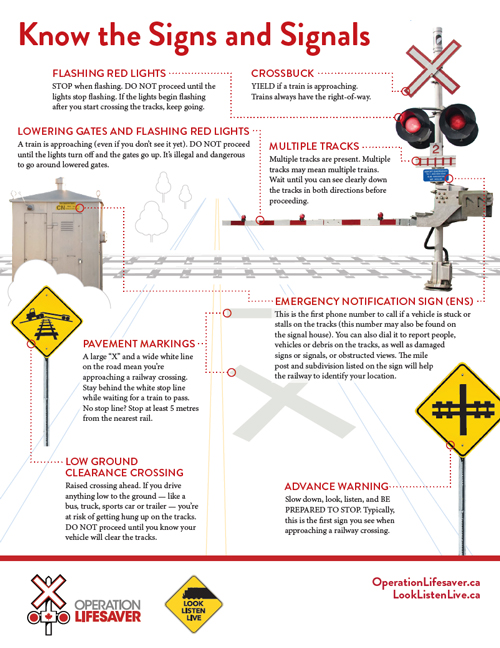Driving & Traffic - Vision Zero
Rail Safety
More than 100 Canadians are killed or are seriously injured each year as a result of collisions at rail crossings and trespassing on railway property. These incidents are devastating for the individuals involved, their friends and family, railway employees, first responders and communities.
Whether you are travelling on foot, in a car, or riding a bike or other recreational vehicle, staying safe around railway tracks is about understanding the signs and signals and responding accordingly.
Rail Safety Tips
Did you know? Trespassing on railway tracks and property is the leading cause of rail-related deaths in Canada. Trespassing on rail property is illegal. Keep these rail safety tips handy, they could save a life.
- Speed misperception - Because of their size, trains appear to be much further away and travelling much slower than their actual speed. Don’t be fooled!
- Trains can't stop quickly - Trains can require over 2 kilometres to stop. Trains can stop, but they can’t stop quickly.
- Trespassing -Taking a shortcut across the tracks or being on railway property is illegal and can get you seriously injured or killed.
- Weight ratio - An average freight train weighs over 5.5 million kg. Compare that to a car, which weighs around 1.375 kg. A train hitting a car is like a car hitting a pop can.
- Railway cars - Stopped railway cars can start at any time. If you’re on one or near one when it moves, you could lose a limb, or your life.
- Tunnels and bridges - If you are caught trespassing in a railway tunnel or on a bridge with a train approaching, you will be struck. Railway tunnels and bridges are only designed for trains.
- Overhang - Trains can carry loads that are wider than the railway cars themselves. They can have chains, straps or other equipment swinging loose from the train. If you are standing too close, you could get hit.
- Anytime is train time -Trains do not always run on a schedule. They can run at any time on any track and come from either direction.
Know the Signs and Signals
- Flashing Red Lights - STOP when flashing. DO NOT proceed until the lights stop flashing. If the lights begin flashing after you start crossing the tracks, keep going.
- Crossbuck - Yield if a train is approaching. Trains always have the right-of-way.
- Lowering Gates and Flashing Red Lights - A train is approaching (even if you don’t see it yet). DO NOT proceed until the lights turn off and the gates go up. It’s illegal and dangerous to go around lowered gates.
- Multiple Tracks are present. Multiple tracks may mean multiple trains. Wait until you can see clearly down the tracks in both directions before proceeding.
- Emergency Notification Sign (ENS) - This is the first phone number to call if a vehicle is stuck or stalls on the tracks (this number may also be found on the signal house). You can also dial it to report people, vehicles or debris on the tracks, as well as damaged signs or signals, or obstructed views. The mile post and subdivision listed on the sign will help the railway to identify your location.
- Pavement Markings - A large “X” and a wide white line on the road mean you’re approaching a railway crossing. Stay behind the white stop line while waiting for a train to pass. No stop line? Stop at least 5 metres from the nearest rail.
- Low Ground Clearance Crossing - Raised crossing ahead. If you drive anything low to the ground - like a bus, truck, sports car or trailer - you’re at risk of getting hung up on the tracks. DO NOT proceed until you know your vehicle will clear the tracks.
- Advance Warning - Slow down, look, listen, and BE PREPARED TO STOP. Typically, this is the first sign you see when approaching a railway crossing.

Date modified
